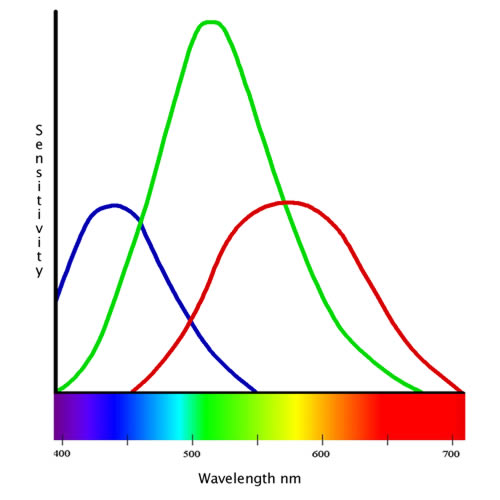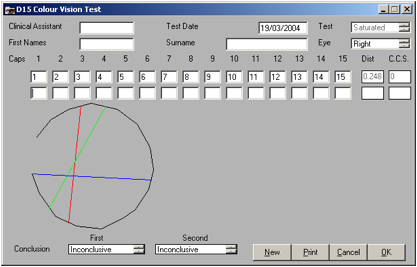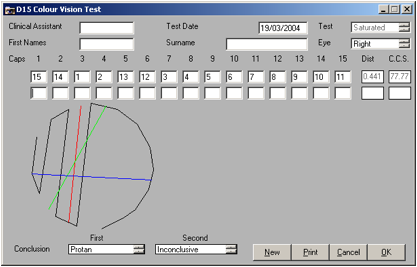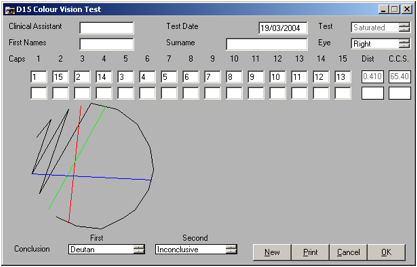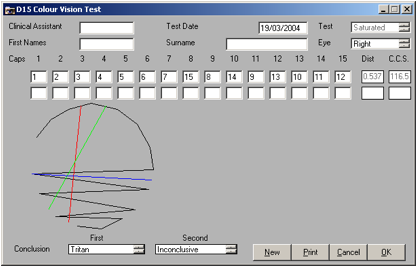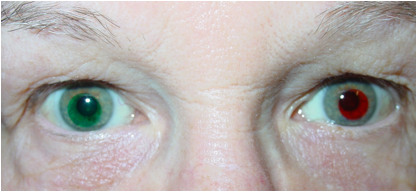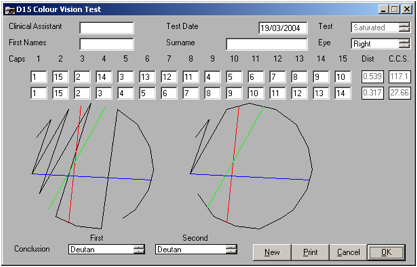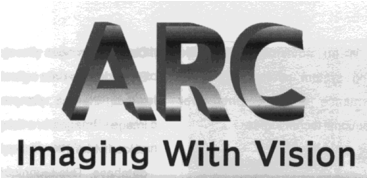How the brain Sees Colour
Visual spectrum is made up from many wavelengths. These fall onto the photoreceptors in the retina at the back of the eye. Colour is perceived by these and is matched using the 3 primary colours, Red, Green and Blue. There are twice as many green cones or receptors in a patient with normal colour vision than red or blue as is shown in the following sensitivity graph.
Types of colour deficiency
Patients with abnormal colour vision generally fall into 2 functional groups, those with poor Red/Green discrimination (deutanopes and protanopes) and those confusing along the Blue/Yellow axis (tritanopes). The tritanope suffers from reduced blue sensitivity, the deutanope, reduced green and the protanope, reduced red sensitivity. The most common form of colour blindness is deutanomalous (partial loss of green sensitivity) or deutanopia (total loss of green sensitivity). The deutanomalous patient is often described as having a green colour deficiency while the deutanope is often refered to as being colour blind. About 5-8% of UK males have abnormal colour vision and about 0.5% of females. The condition is carried on the X part of the XX or XY sex chromosome and is transmitted theoretically to 50% of a carrier mothers male children. 50% of her female children are likely to be carriers. Female children only manifest colour defective vision if they inherit the gene from both their mother and father. A color blind man cannot transmit the condition to his male offspring, since the male always inherits the mother’s X chromosome.
The split between the varying manefestations is:-
Colour Blind |
Colour deficient |
Protanopia (R/G) 1% |
Protanomalous 1% |
Deutanopia (R/G) 1% |
Deuternomalous 5% |
Tritanopia (B/Y) <1% |
Tritanomalous very rare |
What is it like to be colour deficient?
A protanope sees colours with the remaining green and blue mechanisms, so objects are seen with red "washed out" as below on the right hand side of the image, the deutanope sees the image with the green washed out as on the left hand side of the image:-
Colours on the middle of the spectrum are often described as being very similar, having a "muddy" hue. The deutanope also confused a similar part of the spectrum, though the colours perception is skewed compared to the protanope.
Colour Vision Tests
Ishihara Screening Colour Vision Test
D15 Saturated Colour Discimination Test
The ARC Optical D15 Hue Discrimination Test System Scoring was devoped to graphically show the extent and type of colour vision defect. An individual arranging the buttons into the correct order will have the shortest line drawn round the circle drawn in visual colour space, as below and a CCS or Colour Confusion Score of zero. The more the path deviates from this perfect circle the worse the Colour Confusion Score becomes. The biggest deviations come from "cross-overs". The angle these cross-overs, or major confusion axis, indicates whether the patient has a protan, deutan or tritan defect, as seen in the following ARC Optical scoring charts. The later chart shows the effect of a deutan being treated with Chromagen contact lenses and their colour confusion score improving from 117 to 27. This represents a massive improvement in the ability to discriminate between similar colours, rather than simply being able to pass the Ishihara colour blindness screening test.
Normal D15 Score - buttons in correct order 1-15, CCS = 0
Moderate Protan D15 Score - buttons show incorrect path with red axis cross-overs, CCS = 77.77
Moderate Deutan D15 Score - buttons show incorrect path with green axis cross-overs, CCS = 65.40
Moderate Tritan D15 Score - buttons show incorrect path with blue/yellow axis cross-overs, CCS = 116.50
Chromagen for colour blindness
Until recently, there has been no effective treatment for colour vision deficiency, and patients have had to make adjustments in the real world, such as judging traffic lights by their relative position, rather than seeing the lights as different colours.
ChromaGen is a range of spectacle and contact lenses that have been developed to enhance colour perception and identification in people who have "colour blindness". Successful ChromaGen subjects perceive an enhancement in their colour vision with a high degree of satisfaction. A high percentage of the subjects reported significant improvements in colour naming. It also enhanced their everyday lives ( 97.3% ) From files held at Cantor & Silver.
Chromagen contact lenses can be obvious on light coloured eyes in bright lighting conditions, especially where dense tints are required to treat severe cases of colour blindness, much less where people have a darker coloured iris.
Deutan D15 Score - buttons show incorrect path improving with Chromagen Treatment, CCS =117.10 to 27.66
Andrew Matheson is one of approximately 100 eyecare practitioners who treat colour blindness with ChromoGen TM contact lenses and spectacles.
At present these trials are only conducted at the Alresford branch, usually on a Wednesday.
The charge for a ChromoGen trial in addition to a eye exam if deemed necessary, is £129.00
Please phone 01962 734382 or contact us by email to make an appointment.
Please click here to see our colour picker page
